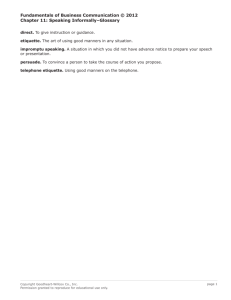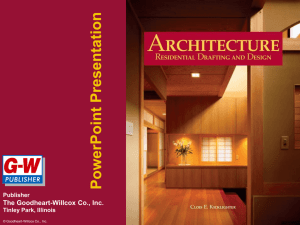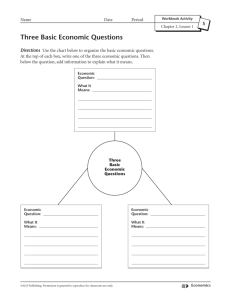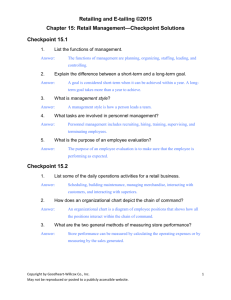Formatting Letters - Goodheart
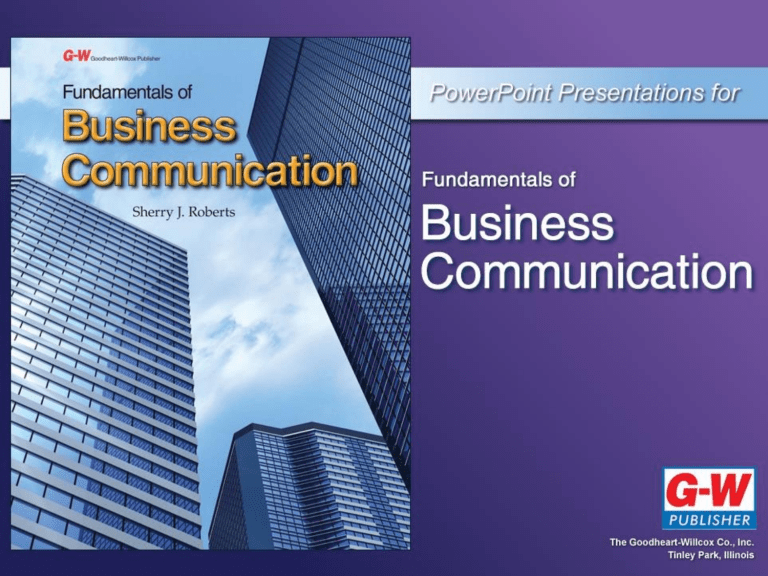
9
“The more elaborate our means of communication, the less we communicate.”
― Joseph Priestly, 18th-century
English theologian
Formatting Letters,
Memos, and E-Mails
After completing the chapter, you will be able to:
• Increase the readability of your writing by applying standard formatting.
• Format letters using standard elements and styles appropriate for business letters.
• Format memos using standard elements and styles appropriate for business memos.
• Use netiquette when creating and formatting e-mails.
© Goodheart-Willcox Co., Inc.
Permission granted to reproduce for educational use only.
Formatting
• Standard formatting— how to set up a document so its appearance follows a convention
• Visual cue— an element the reader sees and interprets to have a particular meaning
• White space— includes margins, space between paragraphs, and any other blank space on the page
• Readability— a measure of how easy it is for the reader to understand your writing and locate information within a document
© Goodheart-Willcox Co., Inc.
Permission granted to reproduce for educational use only.
Formatting
• Enhance readability
– Use headings, which are words and phrases that introduce sections of text.
– Use standard fonts and sizes—default Microsoft
Word 2007/2010 is 11-point Calibri.
– Vary heading font style.
Shutterstock
© Goodheart-Willcox Co., Inc.
Permission granted to reproduce for educational use only.
Formatting
• Enhance readability
– Use parallel structure, which means similar sections or elements contain similar patterns of words to show they are of equal level.
– Use formatting and organizational symbols, such as bulleted lists, numbered lists, asterisks, underlining, or boldface type.
– Use high-quality paper.
© Goodheart-Willcox Co., Inc.
Permission granted to reproduce for educational use only.
1. What is another term for layout?
Answer: format
2. What function do headings serve?
Answer: to introduce sections of text
3. What is another term for typeface?
Answer: font
( continued )
© Goodheart-Willcox Co., Inc.
Permission granted to reproduce for educational use only.
4. What is the maximum number of fonts that should be used in a document?
Answer: two or three
5. What is the purpose of a parallel structure?
Answer: to show that similar sections or elements are of equal level
© Goodheart-Willcox Co., Inc.
Permission granted to reproduce for educational use only.
Formatting Letters
• Block-style letter: all lines are flush with the left margin
© Goodheart-Willcox Co., Inc.
Permission granted to reproduce for educational use only.
Formatting Letters
• Modified-blockstyle letter: date, complimentary close, and signature to the right of the center point of the letter
© Goodheart-Willcox Co., Inc.
Permission granted to reproduce for educational use only.
Formatting Letters
• Standard letter elements
– date
– inside address
– salutation
– body
– complimentary close
– signature line
© Goodheart-Willcox Co., Inc.
Permission granted to reproduce for educational use only.
Formatting Letters
• Date line
– consists of the month, day, and year.
– month is spelled in full
– day is written in figures and followed by a comma.
December 18, 20--
© Goodheart-Willcox Co., Inc.
Permission granted to reproduce for educational use only.
Formatting Letters
• Inside address is the name, title, and address of the recipient.
Ms. Denise Rodriquez
President & CEO
Urban Development Council
150 Grosvenor Avenue
Washington, DC 30005
© Goodheart-Willcox Co., Inc.
Permission granted to reproduce for educational use only.
Formatting Letters
• Salutation
– greeting in a letter
– begins with Dear followed by the recipient’s first name or title and last name
• Mixed punctuation
– colon is placed after the salutation
– comma is placed after the complimentary close
• Open punctuation
– no punctuation after the salutation
– no punctuation after complimentary close
© Goodheart-Willcox Co., Inc.
Permission granted to reproduce for educational use only.
Formatting Letters
• Body of the letter is the message
• Complimentary close is the sign-off for the letter
– mixed punctuation
Sincerely,
– open punctuation
Sincerely
© Goodheart-Willcox Co., Inc.
Permission granted to reproduce for educational use only.
Formatting Letters
• Writer’s name and title are called the signature or signature block
• Enclosure notation alerts the reader to materials that are included with the letter
• Reference initials indicate who keyed the letter
• Copy notation indicates others are being sent a copy of the letter
© Goodheart-Willcox Co., Inc.
Permission granted to reproduce for educational use only.
Formatting Letters
• Additional letter elements
– Attention Line— part of inside address
Attention Marketing Manager
– Subject Line— appears after salutation
Dear Mr. Ramito:
SUBJECT: MINUTES OF MEETING
– Postscript means after writing and is information included after the signature
P.S. Remember, our sale ends this Thursday
© Goodheart-Willcox Co., Inc.
Permission granted to reproduce for educational use only.
Formatting Letters
• Envelopes
– Standard size-10 envelope, 4 1/8 9 1/2
– Address in all capital letters with no punctuation
© Goodheart-Willcox Co., Inc.
Permission granted to reproduce for educational use only.
1. What style of letter formatting has all elements flush with the left margin?
Answer: block-style letter
2. Whose initials are the reference initials?
Answer: the person who keyed the letter
( continued )
© Goodheart-Willcox Co., Inc.
Permission granted to reproduce for educational use only.
3. If cc appears at the bottom of a letter, what does this mean?
Answer: copy (or courtesy copy) of the letter has been sent to the people listed
4. For what is a postscript generally used?
Answer: postscript is no longer used to represent an afterthought, but may be used to emphasize or personalize a point
© Goodheart-Willcox Co., Inc.
Permission granted to reproduce for educational use only.
Formatting Memos
• Memos are intra-office communication.
• generally printed on forms with the company name and logo
• usually use templates, which are predesigned forms with the guide words to, from, date, subject
© Goodheart-Willcox Co., Inc.
Permission granted to reproduce for educational use only.
Formatting Memos
• Parts of a memo
– guide words (TO:, FROM:, DATE:, SUBJECT:)
– body or message
– notations at the bottom of the memo indicate specific things such as c or cc for copies
– no complimentary close
© Goodheart-Willcox Co., Inc.
Permission granted to reproduce for educational use only.
Formatting Memos
• Parts of a memo
© Goodheart-Willcox Co., Inc.
Permission granted to reproduce for educational use only.
1. What guide words appear at the beginning of a memo?
Answer: to, from, date, and subject
2. List the five elements of a memo.
Answer: TO:, FROM:, DATE:, SUBJECT:, body
3. In addition to the standard elements, what else may appear on a memo?
Answer: notations of confidential, attachments, and enclosures
© Goodheart-Willcox Co., Inc.
Permission granted to reproduce for educational use only.
Formatting E-Mail
• E-mail is a message that is created, sent, and received digitally (electronically).
• Use netiquette
– guidelines for appropriate behavior on the Internet
– Standard English
– spell check
• Use the salutation “dear” as in a letter, depending on if you are writing a formal or informal e-mail.
• Format the e-mail message the same as you would a letter or memo.
• Include a complimentary close as in a printed letter.
© Goodheart-Willcox Co., Inc.
Permission granted to reproduce for educational use only.
Formatting E-Mail
• Parts of an e-mail:
– header (to and copy lines)
– salutation
– body
– complimentary close and signature
© Goodheart-Willcox Co., Inc.
Permission granted to reproduce for educational use only.
Formatting E-Mail
• If you address the person by first name face-to-face, it is generally okay to do so in e-mail.
• Be cautious when sending attachments to ensure the recipient can handle the size and type of file.
• Respond as quickly as possible to e-mails.
• Stay with the original topic in your e-mail reply.
Shutterstock
© Goodheart-Willcox Co., Inc.
Permission granted to reproduce for educational use only.
Formatting E-Mail
• E-mail features
– address book
– send options
– reply options
– forward
– folders
– views
– trash/recycle bin
– calendars and planning tools
© Goodheart-Willcox Co., Inc.
Permission granted to reproduce for educational use only.
1. What does the header of an e-mail contain?
Answer: recipients you want a response from or who have a primary interest in the topic, names of those who are receiving the information as secondary recipients, the subject of the e-mail
2. What is the general rule used to determine if you can address somebody by their first name in an e-mail?
Answer: If you address the recipient by first name in person, do the same in written communication
( continued )
© Goodheart-Willcox Co., Inc.
Permission granted to reproduce for educational use only.
3. Why should you alert a recipient that an e-mail you will be sending will contain an attachment?
Answer: to ensure the recipient can handle the size and type of file
4. In addition to following netiquette, what should you do in an e-mail?
Answer: use Standard English and the spelling check feature before sending
© Goodheart-Willcox Co., Inc.
Permission granted to reproduce for educational use only.
• Making a professional impression with your written correspondence is important in any business situation.
• Letters may be block style or modified-block style with either open or mixed punctuation.
• Memos are generally used for interoffice communication.
• E-mails are commonly used in business and are formatted similarly to a memo.
© Goodheart-Willcox Co., Inc.
Permission granted to reproduce for educational use only.
